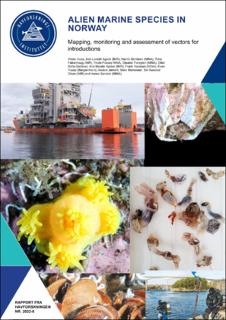| dc.contributor.author | Husa, Vivian | |
| dc.contributor.author | Agnalt, Ann-Lisbeth | |
| dc.contributor.author | Berntsen, Johan Henrik Hårdensson | |
| dc.contributor.author | Falkenhaug, Tone | |
| dc.contributor.author | Fossøy, Frode | |
| dc.contributor.author | Forsgren, Elisabet | |
| dc.contributor.author | Grefsrud, Ellen Sofie | |
| dc.contributor.author | Hjelset, Ann Merete | |
| dc.contributor.author | Hanssen, Frank Ole | |
| dc.contributor.author | Husby, Even | |
| dc.contributor.author | Jelmert, Anders | |
| dc.contributor.author | Mortensen, Stein | |
| dc.contributor.author | Olsen, Siri Aaserud | |
| dc.contributor.author | Sandvik, Hanno | |
| dc.date.accessioned | 2022-05-31T11:15:30Z | |
| dc.date.available | 2022-05-31T11:15:30Z | |
| dc.date.created | 2022-05-30T09:31:44Z | |
| dc.date.issued | 2022-04-28 | |
| dc.identifier.uri | https://hdl.handle.net/11250/2997029 | |
| dc.description.abstract | Norway has the second longest coastline in the world, and it is challenging to monitor non-indigenous marine species (NIMS) along the entire shore including the Norwegian areas in the Barents Sea and along Svalbard. There is currently no national program for such monitoring, however some activity is taking place on specific species and organism groups which is presented here.
Historically transport of NIMS is ballast water have been the main pathway into the Norwegian coast, but with the implementation of the Ballast Water Convention this risk is minimized. Biofouling on vessels coming into the Norwegian coast is thus considered to be the most important vector for marine introduction of new species. An analysis of the frequency and origin (last port call) for 158 000 vessel arrivals into Norwegian ports in the period 2020-2021 is presented. The results show that the Oslofjord area and the west coast is the areas with highest risk for marine introductions by vessels. Other vectors for such introductions into Norway are evaluated like the increasing amount of floating debris which can carry fouling organisms, larvae and eggs to new areas. An analysis of historical data for the established NIMS in Norway show that the southern area of Norway is most susceptible to new species. This pattern is not only dependent on the vector pressure but also reflects the temperature gradient northwards along the coast.
Measures for prevention of new species to arrive and management of problematic species is also discussed. | en_US |
| dc.language.iso | eng | en_US |
| dc.publisher | Havforskningsinstituttet | en_US |
| dc.relation.ispartof | Rapport fra havforskningen | |
| dc.relation.ispartofseries | Rapport fra havforskningen;2022 - 8 | |
| dc.relation.uri | https://www.hi.no/hi/nettrapporter/rapport-fra-havforskningen-en-2022-8 | |
| dc.title | Alien marine species in Norway - Mapping, monitoring and assessment of vectors for introductions | en_US |
| dc.title.alternative | Alien marine species in Norway - Mapping, monitoring and assessment of vectors for introductions | en_US |
| dc.type | Research report | en_US |
| dc.description.version | publishedVersion | en_US |
| dc.source.pagenumber | 107 | en_US |
| dc.source.issue | 2022 - 8 | en_US |
| dc.identifier.cristin | 2027994 | |
| dc.relation.project | Havforskningsinstituttet: 15635-03 | en_US |
| cristin.ispublished | true | |
| cristin.fulltext | original | |
